 Credit:
PrathanChorruangsak
Credit:
PrathanChorruangsak
Products are chosen independently by our editors. Purchases made through our links may earn us a commission.
Air quality is a serious issue, especially in recent years with the rise in concern over viruses and germs combined with added focus on environmental factors like wildfire smoke and chemical emissions.
Fuel-burning appliances, deteriorating insulation, newly installed carpets, household cleaning products, seasonal pollen, pets, and outdoor air pollution are just a few of the sources of unhealthy air inside your home.
If you’re asking yourself if there is something you can do to improve the air you breathe in the place where you live, sleep, and play, then the answer is yes—absolutely!
The answer can be as simple as an air purifier. Read through this, and then you can decide what is the best air purifier for you and your family.
So, what does an air purifier do?
Air purifiers can greatly improve indoor air quality in large and small spaces.
In very basic terms, air purifiers are designed to remove particles and pollutants from the air; these pollutants can trigger allergy symptoms or lead to negative long-term health effects.
Stagnant household air can become polluted by countless sources: From dust, pollen, and mold spores to asbestos, carbon monoxide, formaldehyde, pesticides, and lead. Even the dander and fur or hair from your cat or dog can cause distress.
These pollutants can lead to both short- and long-term health problems, ranging from mild allergy-like symptoms to respiratory diseases and cancer, especially when the space in which they roam doesn’t offer adequate ventilation.
Air purifiers help to remove or reduce pollutants by using a combination of physical filters, devices, chemicals, and techniques. By doing so, air purifiers can improve the indoor air quality of your home, help soothe allergy and asthma symptoms, and get rid of toxins in the air.
How do air purifiers work?

Many of them go about using different methods for cleaning the air.
To understand how an air purifier works, you need to understand the different types of filtration and removal technology on the market.
Air purifiers are tasked with tackling the above pollutants, but all pollutants are not created equal. Likewise, there are many types of air purifiers. Some are designed to capture particulate matter, while others are designed to eliminate them altogether.
Air purifiers may use physical filtration processes, while others may remove particles chemically. Some use a combination of these.
Physical filters act like sieves, but on a microscopic scale, trapping particles as the air moves through them. Chemical pollutants make it through most physical filters, but can be trapped or destroyed by specialist filter technologies.
Fibrous and HEPA air filters trap particles like pollen, dust mites, and pet dander
Fibrous air filters are found in some of the most popular air purifiers and work to physically filter pollutants by trapping particles via the filter fibers. A HEPA (high-efficiency particulate air) filter is one of the most common terms you’ll hear thrown around with air purifiers.
Found in many air purifiers—and vacuum cleaners—on the market, a HEPA filter is a fibrous pleated air filter that removes at least 99.97% of dust, pollen, mold, bacteria, and any other airborne particle with a size of 0.3 microns or more.
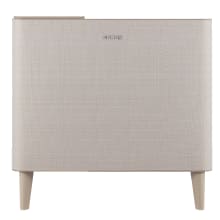
Traps 99.9% of polluted particles in the air.
Electrostatic precipitators and ionizers eliminate harmful pathogens
Electrostatic precipitators (ESPs) and ionizers both use a live wire that charges the particles coming in, and an oppositely charged electric plate collects the particles as they pass through the air purifier.
Wei-Ning Wang, Ph.D., associate professor of mechanical and nuclear engineering at the Virginia Commonwealth University’s College of Engineering, explains, “Since almost all particulate matter, including airborne pathogens, carry charges (mostly negative charges), this technique uses electrostatic interactions to attract the particles and/or use high electric current to kill the pathogens.”
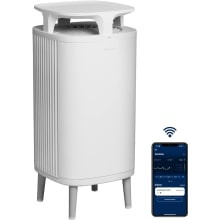
Cleans the air by capturing 99% of dust before it settles.
Ultraviolet germicidal irradiation kill viruses and bacteria
Ultraviolet germicidal irradiation (UVGI) air purifiers use UV lamps to kill biological material like viruses, bacteria, and mold.
Wang says, “UV irradiation is a widely adopted technique to kill pathogens, which can also be incorporated into the air purifiers to further enhance the antipathogen capability.”
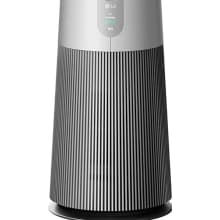
Kills bacteria as it captures 99% of dust in the air.
Chemicals stick to sorbent media like activated carbon
Some chemical filters work by trapping the chemicals on their surface. Activated carbon is a popular chemical trapper as it’s inexpensive and has an extremely high surface area. Chemicals in the air react with the carbon surface and stay locked inside the filter rather than returning to your room air.
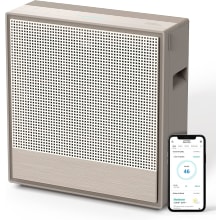
Eliminates all polluted particles while bettering the air quality from unwanted odors.
Photocatalytic oxidation destroys chemical pollution
Photocatalytic oxidation (PCO) uses a light activated catalyst to produce highly reactive molecules called free radicals. These react with harmful chemicals in the air and break them down into, hopefully, harmless byproducts.
The free radicals from PCO can also destroy airborne bacteria and viruses.
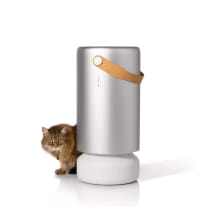
Use PECO technology and true HEPA 99.97% particle-capture efficiency rate to capture and destroy pollutants in large spaces.
Plasma air purifiers break down chemicals in the air
Plasma air purifiers perform similarly to PCO, in that they also destroy pollutants using free radicals. The difference from PCO is that plasma purifiers use high voltage electrodes to create the free radicals.
It's important to be aware that PCO and plasma air purifiers may produce ozone, which is a known lung irritant or in some cases may not fully destroy chemical pollutants.
If we test air purifiers with the potential to create ozone we check that they’ve been certified as ozone safe.
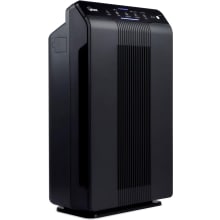
Comes with a washable True HEPA filter.
What is clean air delivery rate, or CADR?
The clean air delivery rate (CADR) is the volume of air that an air purifier cleans in one minute. The CADR rating is significant as it shows how quickly and effectively an air purifier removes pollution.
Air purifiers typically have separate CADR numbers for different types of pollution, for example pollen vs. smoke. This is because pollen and smoke particles have different size ranges, and CADRs are measured separately for each particle size.
The CADR rating can also help you choose the right size of air purifier for your living space. The Association of Home Appliance Manufacturers (AHAM) suggests you choose an air purifier with a CADR in cubic feet per minute that’s at least two thirds of the square footage of your living space.
The two thirds rule gives you a minimum rating for the air purifier you need. It may be worth aiming for a higher CADR purifier as it will clean the space more quickly.
What kind of air purifier is best for you?

Pick the right one for you.
When we tested to find the best air purifiers, we looked at the effectiveness, filter capture, user-friendliness, and aesthetics of each machine. Out of these factors, the most important part of an air purifier is the filter technology.
But, don’t get caught up thinking that air purifiers that use HEPA filters are the only ones to use.
Wang explains, “Depending on the types and/or levels of air pollution, consumers could choose air filters with different capture capabilities. The American Society of Heating, Refrigerating, and Air-Conditioning Engineers (ASHRAE) has a minimum efficiency reporting value (MERV) system to evaluate the efficiency of an air filter. The higher the value, the better the capture efficiency.”
In fact, many air purifiers combine multiple technologies to provide a holistic filtration system that can combat both large particulate matter and VOCs. You’ll often see air purifiers pair HEPA filters with an activated carbon filter or an ionizer for this reason. So, if you want a filter that provides better coverage against several types of pollutants, we suggest looking at purifiers that include multiple types of filtration systems.
Additionally, make sure the air purifier has the proper certifications and meets important regulations put forth by ASHRAE, Energy Star, and the EPA.
If your main concern is easing allergy symptoms with an air purifier, find one that features a HEPA filter.
Wang says, “This is sufficient for most allergies, such as bacteria and mold, the sizes [of which] are generally in the micrometer range.”
If your main concern is VOCs—more common in the home than you might think, from sources like paints, vinyl, upholstery, cooking, burning wood, and even cosmetics like nail polish—a HEPA filter will not be able to help. Instead, you need to opt for an air purifier that contains sorbent media, like activated carbon.
Wang says, “The activated carbon filters can efficiently remove most VOCs through absorption thanks to their porous structure and large specific surface area. These two filters are often used together to remove particulate matter and VOCs simultaneously.”
Should I buy an air purifier?
Yes, it’s a solid household investment, no matter the room size of your home or apartment. The reality is that you’re facing common pollutants in the air wherever you live, and an air purifier will help mitigate any short and long-term dangers to your health. Check out our guide to the best air purifiers we’ve ever tested.
Other ways to improve air quality inside the home
Open your windows—maybe
Improved ventilation can definitely help clear the air in your home, but this comes with a few big caveats. First, open windows can also increase HVAC costs if you’re already running AC or heating. Second, if you suffer from seasonal allergies, opening your windows will let pollen in and just exacerbate your symptoms. Lastly, if you live next to a highway you may be letting in some toxic gasses, which again, simply isn’t beneficial to the air you breathe or your health.
Install an air quality meter in your home
To become more aware of what’s actually polluting the air inside your home, if anything, it’s not a bad idea to install an air quality monitor. This is a secondary way of checking air quality, and one can generally provide more information than you can get from the sensors on air purifiers with an automatic mode, since these usually just register particle levels.
Air quality monitors are able to identify mold and fungi, particulates that are the side effects of cooking, smoke, and dust, and even VOCs. Some can even detect harmful pollutants including carbon monoxide and radon.
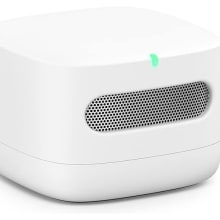
Track and measure the air quality with Alexa.
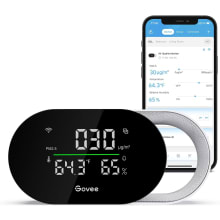
Multifunctional air quality detector. Compatible with the Govee app.
Try using a humidifier or a dehumidifier
Keeping an intermediate humidity level around 50% RH is important in your home. Why? Drier air can aggravate allergies as particles become airborne more easily, but If conditions are too humid, then there's the danger of mold.
Depending on your situation, a humidifier or a dehumidifier can help get you to that perfect balance.
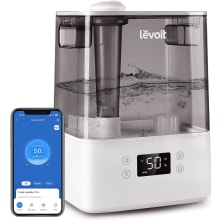
Captures minerals in the water in your humidifier & helps reduce white dust. Comes with replacement filters.
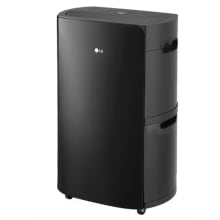
Built-in drain pump feature allows for continuous drainage.

